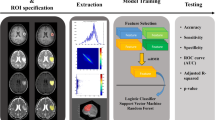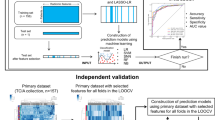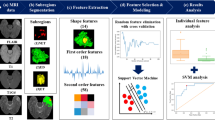Abstract
Background
The peritumoral region (PTR) of glioblastoma (GBM) appears as a T2W-hyperintensity and is composed of microscopic tumor and edema. Infiltrative low grade glioma (LGG) comprises tumor cells that seem similar to GBM PTR on MRI. The work here explored if a radiomics-based approach can distinguish between the two groups (tumor and edema versus tumor alone).
Methods
Patients with GBM and LGG imaged using a 1.5 T MRI were included in the study. Image data from cases of GBM PTR, and LGG were manually segmented guided by T2W hyperintensity. A set of 91 first-order and texture features were determined from each of T1W-contrast, and T2W-FLAIR, diffusion-weighted imaging sequences. Applying filtration techniques, a total of 3822 features were obtained. Different feature reduction techniques were employed, and a subsequent model was constructed using four machine learning classifiers. Leave-one-out cross-validation was used to assess classifier performance.
Results
The analysis included 42 GBM and 36 LGG. The best performance was obtained using AdaBoost classifier using all the features with a sensitivity, specificity, accuracy, and area of curve (AUC) of 91%, 86%, 89%, and 0.96, respectively. Amongst the feature selection techniques, the recursive feature elimination technique had the best results, with an AUC ranging from 0.87 to 0.92. Evaluation with the F-test resulted in the most consistent feature selection with 3 T1W-contrast texture features chosen in over 90% of instances.
Conclusions
Quantitative analysis of conventional MRI sequences can effectively demarcate GBM PTR from LGG, which is otherwise indistinguishable on visual estimation.




Similar content being viewed by others
Data Availability
Data will be made available on request to the corresponding author following institutional ethics committee protocols.
Code availability
The radiomic feature extraction was performed using freely available Pyradiomics software (http://www.pyradiomics.io/pyradiomics.html). All standardization, model fitting, and assessment were performed using Scikit-Learn (https://scikit-learn.org/stable).
References
Lambin P, Rios-Velazquez E, Leijenaar R et al (2012) Radiomics: Extracting more information from medical images using advanced feature analysis. Eur J Cancer 48:441–446. https://doi.org/10.1016/j.ejca.2011.11.036
Gillies RJ, Kinahan PE, Hricak H (2015) Radiomics: images are more than pictures, they are data. Radiology 278:563–577. https://doi.org/10.1148/radiol.2015151169
Lambin P, Leijenaar RTH, Deist TM et al (2017) Radiomics: the bridge between medical imaging and personalized medicine. Nat Rev Clin Oncol 14:749–762. https://doi.org/10.1038/nrclinonc.2017.141
Louis DN, Perry A, Wesseling P et al (2021) The 2021 WHO classification of tumors of the central nervous system: a summary. Neuro Oncol. https://doi.org/10.1093/neuonc/noab106
Barajas RF, Phillips JJ, Parvataneni R et al (2012) Regional variation in histopathologic features of tumor specimens from treatment-naive glioblastoma correlates with anatomic and physiologic MR Imaging. Neuro Oncol 14:942–954. https://doi.org/10.1093/neuonc/nos128
Eidel O, Burth S, Neumann J-O et al (2017) Tumor infiltration in enhancing and non-enhancing parts of glioblastoma: a correlation with histopathology. PLoS ONE 12:e0169292. https://doi.org/10.1371/journal.pone.0169292
Dasgupta A, Geraghty B, Maralani PJ et al (2021) Quantitative mapping of individual voxels in the peritumoral region of IDH-wildtype glioblastoma to distinguish between tumor infiltration and edema. J Neurooncol 153:251–261. https://doi.org/10.1007/s11060-021-03762-2
Yushkevich PA, Piven J, Hazlett HC et al (2006) User-guided 3D active contour segmentation of anatomical structures: significantly improved efficiency and reliability. Neuroimage 31:1116–1128. https://doi.org/10.1016/j.neuroimage.2006.01.015
Duron L, Balvay D, Vande Perre S et al (2019) Gray-level discretization impacts reproducible MRI radiomics texture features. PLoS ONE 14:e0213459. https://doi.org/10.1371/journal.pone.0213459
Carré A, Klausner G, Edjlali M et al (2020) Standardization of brain MR images across machines and protocols: bridging the gap for MRI-based radiomics. Sci Rep 10:12340. https://doi.org/10.1038/s41598-020-69298-z
Pedregosa F, Varoquaux G, Gramfort A, et al Scikit-learn: Machine Learning in Python. MACHINE LEARNING IN PYTHON 6
Jain AK, Duin RPW, Mao J (2000) Statistical pattern recognition: a review. IEEE Trans Pattern Anal Mach Intell 22:4–37. https://doi.org/10.1109/34.824819
Lundy P, Domino J, Ryken T et al (2020) The role of imaging for the management of newly diagnosed glioblastoma in adults: a systematic review and evidence-based clinical practice guideline update. J Neurooncol 150:95–120. https://doi.org/10.1007/s11060-020-03597-3
Beig N, Bera K, Tiwari P (2020) Introduction to radiomics and radiogenomics in neuro-oncology: implications and challenges. Neurooncol Adv. https://doi.org/10.1093/noajnl/vdaa148
Lohmann P, Galldiks N, Kocher M et al (2021) Radiomics in neuro-oncology: Basics, workflow, and applications. Methods 188:112–121. https://doi.org/10.1016/j.ymeth.2020.06.003
D’Alessio A, Proietti G, Sica G, Scicchitano BM (2019) Pathological and molecular features of glioblastoma and its peritumoral Tissue. Cancers (Basel) 11:E469. https://doi.org/10.3390/cancers11040469
Sattiraju A, Mintz A (2019) Pericytes in glioblastomas: multifaceted role within tumor microenvironments and potential for therapeutic interventions. Adv Exp Med Biol 1147:65–91. https://doi.org/10.1007/978-3-030-16908-4_2
Galli R, Binda E, Orfanelli U et al (2004) Isolation and characterization of tumorigenic, stem-like neural precursors from human glioblastoma. Cancer Res 64:7011–7021. https://doi.org/10.1158/0008-5472.CAN-04-1364
Petrecca K, Guiot M-C, Panet-Raymond V, Souhami L (2013) Failure pattern following complete resection plus radiotherapy and temozolomide is at the resection margin in patients with glioblastoma. J Neurooncol 111:19–23. https://doi.org/10.1007/s11060-012-0983-4
Prasanna P, Patel J, Partovi S et al (2017) Radiomic features from the peritumoral brain parenchyma on treatment-naïve multi-parametric MR imaging predict long versus short-term survival in glioblastoma multiforme: Preliminary findings. Eur Radiol 27:4188–4197. https://doi.org/10.1007/s00330-016-4637-3
Forst DA, Nahed BV, Loeffler JS, Batchelor TT (2014) Low-grade gliomas. Oncologist 19:403–413. https://doi.org/10.1634/theoncologist.2013-0345
Singh G, Manjila S, Sakla N et al (2021) Radiomics and radiogenomics in gliomas: a contemporary update. Br J Cancer 125:641–657. https://doi.org/10.1038/s41416-021-01387-w
Certo F, Altieri R, Maione M et al (2020) FLAIRectomy in supramarginal resection of glioblastoma correlates with clinical outcome and survival analysis: a prospective, single institution. Case Series Oper Neurosurg (Hagerstown). https://doi.org/10.1093/ons/opaa293
Jackson C, Choi J, Khalafallah AM et al (2020) A systematic review and meta-analysis of supratotal versus gross total resection for glioblastoma. J Neurooncol 148:419–431. https://doi.org/10.1007/s11060-020-03556-y
Azoulay M, Chang SD, Gibbs IC et al (2020) A phase I/II trial of 5-fraction stereotactic radiosurgery with 5-mm margins with concurrent temozolomide in newly diagnosed glioblastoma: primary outcomes. Neuro Oncol 22:1182–1189. https://doi.org/10.1093/neuonc/noaa019
Acknowledgements
We express our sincere gratitude to the patients and their caregivers involved in the study. We would like to thank the Terry Fox Foundation Program Project Grant from the Hecht Foundation for the funding support associated with the study.
Funding
Terry Fox Foundation Program Project Grant from the Hecht Foundation (1083) awarded to Gregory J. Czarnota. The funding bodies had no influence on the study design, data collection, analysis, interpretation of data, or the manuscript's writing.
Author information
Authors and Affiliations
Contributions
Conceptualization: AD, BG, AS, GJC; Methodology: All authors; Formal Analysis and investigation: All authors; Writing-original draft preparation: NM, AD, BG, AS, GJC; Writing-review and editing: All authors; Project administration and supervision: AS, GJC; Funding acquisition: GJC. All the authors are in agreement and accountable for all the aspects of the work.
Corresponding author
Ethics declarations
Conflict of interest
Nauman Malik: None. Benjamin Geraghty: None. Archya Dasgupta: None. Pejman Maralani: None. Michael Sandhu: None. Jay Detsky: None. Chia-Lin Tseng: Travel accommodations/expenses & honoraria for past educational seminars by Elekta, belongs to the Elekta MR-Linac Research Consortium, and advisor/consultant with Sanofi. Hany Soliman: None. Sten Myrehaug: Travel accommodations/expenses from Elekta AB. Research support from Novartis/AAA. Zain Husain: Travel accommodations/expenses from Elekta. James Perry: None. Angus Lau: None. Arjun Sahgal: Advisor/consultant with AbbVie, Merck, Roche, Varian (Medical Advisory Group), Elekta (Gamma Knife Icon), BrainLAB, and VieCure (Medical Advisory Board). Board Member: International Stereotactic Radiosurgery Society (ISRS). Past educational seminars with Elekta AB, Accuray Inc., Varian (CNS Teaching Faculty), BrainLAB, Medtronic Kyphon. Research grant with Elekta AB. Travel accommodations/expenses by Elekta, Varian, BrainLAB. Elekta MR Linac Research Consortium, Elekta Spine, Oligometastases and Linac Based SRS Consortia. Gregory J. Czarnota: Funding received from the Terry Fox Foundation Program Project Grant.
Additional information
Publisher's Note
Springer Nature remains neutral with regard to jurisdictional claims in published maps and institutional affiliations.
Supplementary Information
Below is the link to the electronic supplementary material.
Rights and permissions
About this article
Cite this article
Malik, N., Geraghty, B., Dasgupta, A. et al. MRI radiomics to differentiate between low grade glioma and glioblastoma peritumoral region. J Neurooncol 155, 181–191 (2021). https://doi.org/10.1007/s11060-021-03866-9
Received:
Accepted:
Published:
Issue Date:
DOI: https://doi.org/10.1007/s11060-021-03866-9




